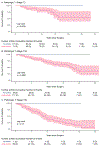Proposal for an optimised definition of adverse pathology (unfavourable histology) that predicts metastatic risk in prostatic adenocarcinoma independent of grade group and pathological stage
- PMID: 38828674
- PMCID: PMC11365761
- DOI: 10.1111/his.15231
Proposal for an optimised definition of adverse pathology (unfavourable histology) that predicts metastatic risk in prostatic adenocarcinoma independent of grade group and pathological stage
Abstract
Aims: Histological grading of prostate cancer is a powerful prognostic tool, but current criteria for grade assignment are not fully optimised. Our goal was to develop and test a simplified histological grading model, based heavily on large cribriform/intraductal carcinoma, with optimised sensitivity for predicting metastatic potential.
Methods and results: Two separate non-overlapping cohorts were identified: a 419-patient post-radical prostatectomy cohort with long term clinical follow-up and a 209-patient post-radical prostatectomy cohort in which all patients had pathologically confirmed metastatic disease. All prostatectomies were re-reviewed for high-risk histological patterns of carcinoma termed 'unfavourable histology'. Unfavourable histology is defined by any classic Gleason pattern 5 component, any large cribriform morphology (> 0.25 mm) or intraductal carcinoma, complex intraluminal papillary architecture, grade 3 stromogenic carcinoma and complex anastomosing cord-like growth. For the outcome cohort, Kaplan-Meier analysis compared biochemical recurrence, metastasis and death between subjects with favourable and unfavourable histology, stratified by pathological stage and grade group. Multivariable Cox proportional hazards models evaluated adding unfavourable histology to the Memorial Sloan Kettering Cancer Center (MSKCC) post-prostatectomy nomogram and stratification by percentage of unfavourable histology. At 15 years unfavourable histology predicted biochemical recurrence, with sensitivity of 93% and specificity of 88%, metastatic disease at 100 and 48% and death at 100 and 46%. Grade group 2 prostate cancers with unfavourable histology were associated with metastasis independent of pathological stage, while those without had no risk. Histological models for prediction of metastasis based on only large cribriform/intraductal carcinoma or increasing diameter of cribriform size improved specificity, but with lower sensitivity. Multivariable Cox proportional hazards models demonstrated that unfavourable histology significantly improved discriminatory power of the MSKCC post-prostatectomy nomogram for biochemical failure (likelihood ratio test P < 0.001). In the retrospective review of a separate RP cohort in which all patients had confirmed metastatic disease, none had unequivocal favourable histology.
Conclusions: Unfavourable histology at radical prostatectomy is associated with metastatic risk, predicted adverse outcomes better than current grading and staging systems and improved the MSKCC post-prostatectomy nomogram. Most importantly, unfavourable histology stratified grade group 2 prostate cancers into those with and without metastatic potential, independent of stage. While unfavourable histology is driven predominantly by large cribriform/intraductal carcinoma, the recognition and inclusion of other specific architectural patterns add to the sensitivity for predicting metastatic disease. Moreover, a simplified dichotomous model improves communication and could increase implementation.
Keywords: Gleason; adenocarcinoma; cribriform; grade; prostate.
© 2024 The Author(s). Histopathology published by John Wiley & Sons Ltd.
Conflict of interest statement
Conflict of Interest declaration: The authors declare that they have NO affiliations with or involvement in any organization or entity with any financial interest in the subject matter or materials discussed in this manuscript.
Figures





References
-
- Sanda MG, Cadeddu JA, Kirkby E, et al. Clinically Localized Prostate Cancer: AUA/ASTRO/SUO Guideline. Part II: Recommended Approaches and Details of Specific Care Options. J Urol 2018;199(4):990–997. - PubMed
-
- Sanda MG, Cadeddu JA, Kirkby E, et al. Clinically Localized Prostate Cancer: AUA/ASTRO/SUO Guideline. Part I: Risk Stratification, Shared Decision Making, and Care Options. J Urol 2018;199(3):683–690. - PubMed
-
- Bailar JC 3rd, Mellinger GT, Gleason DF. Survival rates of patients with prostatic cancer, tumor stage, and differentiation--preliminary report. Cancer Chemother Rep 1966;50(3):129–36. - PubMed
-
- Gleason DF, Mellinger GT. Prediction of prognosis for prostatic adenocarcinoma by combined histological grading and clinical staging. J Urol 1974;111(1):58–64. - PubMed
-
- Epstein JI, Allsbrook WC Jr., Amin MB, Egevad LL, Committee IG. The 2005 International Society of Urological Pathology (ISUP) Consensus Conference on Gleason Grading of Prostatic Carcinoma. Am J Surg Pathol 2005;29(9):1228–42. - PubMed
MeSH terms
Grants and funding
LinkOut - more resources
Full Text Sources
Medical

